NORFOLK, Va. — It may be the new normal.
For the second time in recent months, a Navy aircraft carrier strike group left for exercises and didn't come back.
This time, it is the Norfolk-based USS Dwight D. Eisenhower Carrier Strike Group.
In a posting on the Ike's Facebook page on Thursday, the Chief of Naval Operations Adm. Mike Gilday wrote: "Godspeed to the men and women of the Eisenhower Carrier Strike Group who deployed today. The work these sailors do in the coming months will ensure continued freedom of the seas and the liberties we enjoy at home."
In late November, the USS Harry S. Truman did the same thing, leaving for exercises and never returning. The Navy announced after the fact that Truman had deployed. It is now operating n the North Arabian Sea.
The Navy is not saying where the Eisenhower is bound.
A news release from Commander U.S. second Fleet says:
"The Nimitz-class aircraft carrier USS Dwight D. Eisenhower (CVN 69) and the ships and aircraft of Carrier Strike Group TEN (CSG-10), departed for deployment after successfully completing the Composite Unit Training Exercise (COMPTUEX).
"'The Sailors of IKE Strike Group are trained and ready to execute the full spectrum of maritime operations in any theater,' said Rear Adm. Paul Schlise, commander, Carrier Strike Group 10. Carrier Strike Groups are visible and powerful symbols of U.S. commitment and resolve to our allies and partners, and possess the flexibility and sustainability to fight major wars and ensure freedom of the seas.
"COMPTUEX is designed to fully integrate CSG-10 as a cohesive, multi-mission fighting force, and test the group’s ability to carry out sustained combat operations from the sea. During IKE’s COMPTUEX, several international allies, including ships from the Royal Canadian Navy, the French Navy and the Danish Navy supported and were integrated into the exercise.
"'There is simply no substitute for our integration among our Navies,” said Vice Adm. Andrew Lewis, commander, U.S. 2nd Fleet. “It is the bedrock of our ability to assure our allies, respond to threats and enable global operations. Our Allies’ participation in COMPTUEX directly enhances defense relationships and improves overall coordination and interoperability among our militaries.”
"French anti-submarine frigate FS Normandie (D651), Royal Danish Navy frigate Iver Huitfeldt (F361) and Canadian Halifax-class frigate HMCS Ville de Quebec (FFH 332) participated in several events throughout the exercise. Their participation brought a new layer of depth and increased the training value for all units.
"Exercises such as COMPTUEX demonstrate the importance of interoperability between allied nations,” said Cmdr. Michael Eelhart, commanding officer of the Royal Canadian Navy’s Halifax-class frigate HMCS Ville de Québec (FFH 332). “Specifically, the requirement to integrate allied assets and capabilities in order to achieve a common mission."
"The Dwight D. Eisenhower Carrier Strike Group is a multiplatform team of ships, aircraft and more than 6,000 Sailors, capable of carrying out a wide variety of missions around the globe.
"Deploying ships and aircraft of the strike group, commanded by Rear Adm. Paul J. Schlise, include flagship USS Dwight D. Eisenhower (CVN 69), commanded by Capt. Kyle P. Higgins; the nine squadrons of Carrier Air Wing THREE (CVW 3), staffs of Carrier Strike Group TEN (CSG 10) and Destroyer Squadron TWO SIX (DESRON 26), the guided-missile cruisers USS San Jacinto (CG 56) and USS Vella Gulf (CG 72), the guided-missile destroyers of DESRON 26, USS Stout (DDG 55), USS James E. Williams (DDG 95), and USS Truxton (DDG 103) stationed at Naval Station Norfolk, Virginia.
"Squadrons of Carrier Air Wing (CVW) 3, commanded by Capt. Trevor Estes, embarked on Eisenhower include the “Fighting Swordsmen” of Strike Fighter Squadron (VFA) 32, the “Gunslingers” of Strike Fighter Squadron VFA-105, the “Rampagers” of Strike Fighter Squadron VFA-83, “Wildcats” of VFA-131, the “Screwtops” of Carrier Airborne Early Warning Squadron (VAW) 123, the “Zappers” of Electronic Attack Squadron (VAQ) 130, the “Dusty Dogs” of Helicopter Sea Combat Squadron (HSC) 7, and the “Swamp Foxes” of Helicopter Maritime Strike Squadron (HSM) 74.
"C2F exercises operational authorities over assigned ships, aircraft, and landing forces on the East Coast and the Atlantic. When directed, C2F conducts exercises and operations within the U.S. European Command area of operations as an expeditionary fleet, providing Naval Forces Europe an additional maneuver arm to operate forces dynamically in theater."

